Ferrari 458 Spider
-new?width=768&height=1024)
TECHNOLOGY, DESIGN AND BEAUTY
The 458 Spider is the first car ever to combine a mid-rear engine with a retractable folding hard top that delivers both unprecedented in-cabin comfort when closed and unparalleled Spider performance.

COMBINING COMFORT, LIGHTWEIGHT CONSTRUCTION, FUNCTIONALITY AND PERFORMANCE
The first advantage of a retractable hard top is that it significantly improves in-car comfort when closed, as it insulates. The 458 Spider’s unique hard top doesn’t deform because of the pressure field that builds up at high speeds either. Cabin space and comfort are actually improved thanks to the roof’s double curvature, an element made possible by its aluminium construction but impossible to achieve with a traditional canvas soft top.
The retractable hard top’s structure is incredibly light too, thanks to a simple yet ingenious mechanism. It actually weighs 40 kg less than a traditional hard top and 25 kg less than a fabric version. Its simplicity also ensures its speedy and graceful deployment as well as ensuring it is extremely compact and aerodynamically efficient. As the two sections of the roof rotate simultaneously, the 458 Spider’s hard top takes just 14 seconds to deploy or retract.
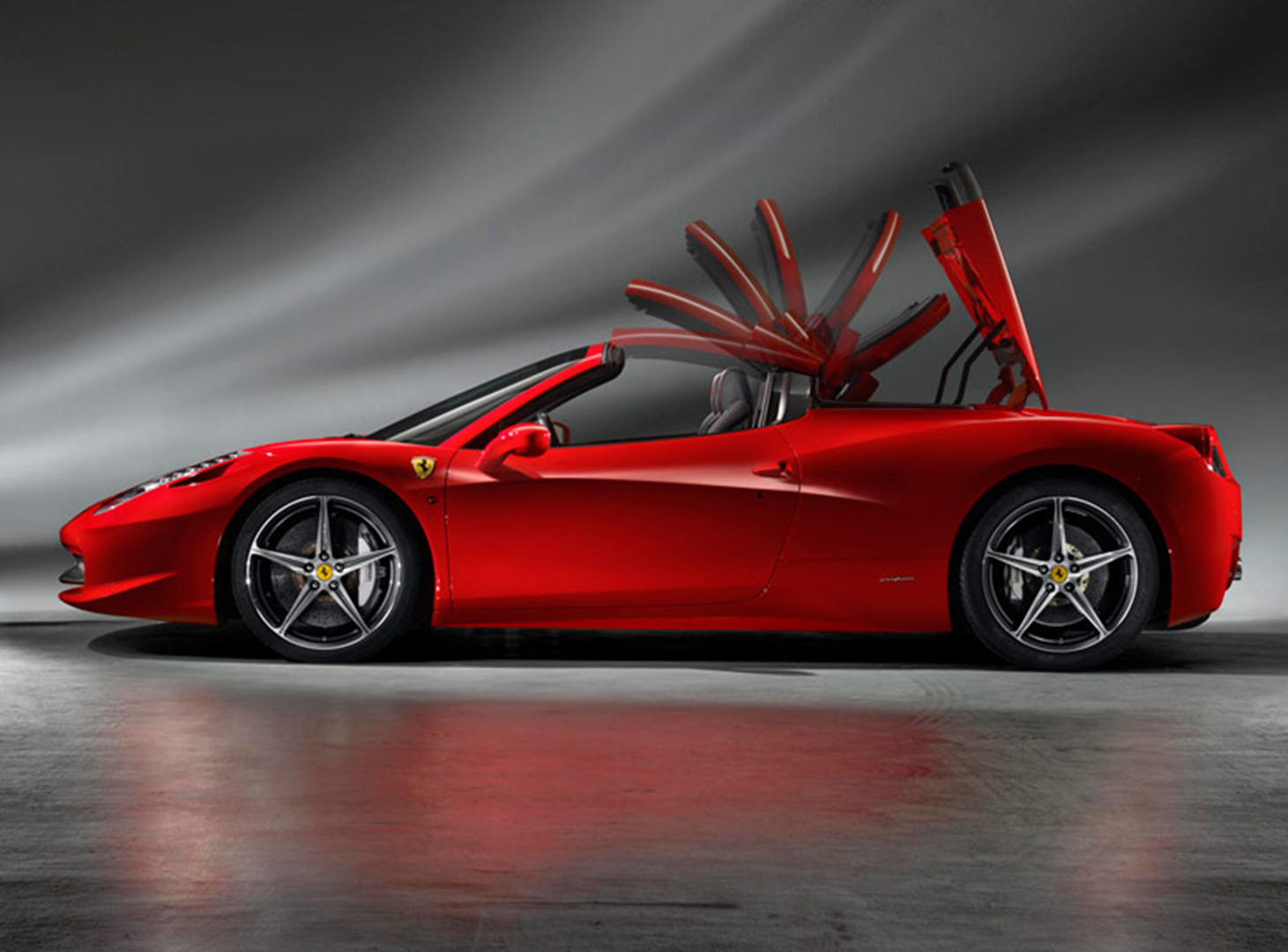
It also tucks away neatly into a 100 litre space in front of the engine bay – a huge achievement given that the roofs on most retractable hard top cars usually take up 150-200 litres. However, this incredible compactness was vital to retaining the superb aerodynamics and styling of the rear of the car and also the engine’s mid-rear position. Drop-top driving is an absolutely uniquely exhilarating experience. However, correct distribution of the airflow inside the cockpit is vital to ensuring occupants fully enjoy the top-down experience without any unpleasant turbulence. This is why Ferrari has installed an electric wind stop in the 458 Spider: once the hard top has completed folding away, the latter automatically raises to about a third of its maximum height, the optimal position established in wind tunnel testing on a 1:1 scale model.
That position may, however, be adjusted by the driver both with the top up or down. It can be completely lowered so that occupants get the full benefit of the car’s soundtrack even when the car is in coupé configuration. Design-wise, these results are the product of having moved the cut-line for the start of the roof from the waist-line to the top of the B-pillar. This simplifies the shape of the roof, making it two-dimensional with the result that it can be divided into two sections which overlap during folding.


INTERNATIONAL ENGINE OF THE YEAR 2012
One of the main differences between this installation and that of the coupé version lies in the location of the engine air intakes. These are no longer on the B-pillars of the car, as was the case with the 458 Italia, but have been moved back to the rear spoiler where the gearbox and clutch radiators are all situated.The new air intake position also meant that the inlet tracts had to be redesigned to guarantee drivers of the 458 Spider the same driving pleasure delivered by the naturallyaspirated Ferrari V8 with the top down, and a specific mix of intake and exhaust sounds was honed to suit the car’s openair remit. Intake and exhaust inputs were equalised at between 3,000 and 5,000 rpm with calibrations of 3-5 dB, thanks to specifically developed silencers.
The soundtrack that occupants hear in the cabin is particularly exhilarating with the top up too, thanks to work done on the harmonics. By partially lowering the wind stop in this configuration, drivers will find themselves even more enthralled by the sound.

The 458 Spider is particularly efficient in terms of its fuel consumption and emissions. This was achieved through a whole series of modifications, including the introduction of the HELE (High Emotion Low Emissions) System which incorporates key components such as: Stop&Start, which cuts fuel consumption by around 10 percent in urban cycles; a low-pressure fuel pump; Pulse Width Modulation-controlled brushless fans (the brushes are replaced by permanent magnets which completely eliminate friction), resulting in an overall reduction in consumption of around 6 percent; and an electronic variable displacement airconditioning compressor.
When the gears shift, the opening and closing phases of the two clutches overlap with the result that shifting time is slashed to practically zero with no torque interruption and the smoothness of an automatic transmission: the result is a benchmark for sportiness, performance and comfort. The 458 Spider’s sporty character is also enhanced by specific attention to the final gear ratio and first and seventh gears. The result is plenty of low-down torque, strong acceleration through the rev range and a seventh that is geared for reaching the car’s maximum speed.


EXCEPTIONAL HANDLING, SAFETY AND LIGHTNESS
Its second generation aluminium chassis is made at the Polo Scaglietti facility in Modena, a centre of excellence in aluminium fabrication which not only benefits from Ferrari’s own in-house skill-set but also associated universities and technical partners worldwide. Several different types of aluminium alloy are used to make the 458 Spider’s chassis, each one with its own specific function: two alloys are used to produce thinner castings (30% thinner than the first generation); five high resistance alloys were used for the extrusions (yield strength is 80% higher than on previous alloys); three for the thin panelling (-25%); specific alloys were also used for the front and rear crash boxes to guarantee maximum energy absorption. Alongside these high-tech materials, Ferrari also uses the most advanced forming technologies (including Superplastic forming to make highly complex shapes less than 1 mm thick).

Various different joining techniques were also adopted to reduce weight and to deliver a high standard of structural rigidity. Significant attention was also focused on minimising the number of components in the car (particularly in the case of the door structure), to improve both performance and safety.
New solutions include more robust sills and the introduction of structural buttresses which considerably increase torsional rigidity and beam stiffness (both + 23 per cent compared to the Ferrari F430’s figures). The latter also provide roll-over protection, a function normally the sole domain of two highly visible roll-bars. This solution guarantees an exceptional standard of safety and easily exceeds the most severe safety requirements in this regard.


REDUCING DRAG AND INCREASING DOWNFORCE
The 458 Spider is about 12 percent more aerodynamically efficient than the F430 Spider. Its nose features two small aeroelastic winglets which generate downforce at the front of the car and, as speed rises, deform to reduce the section of the radiator inlets and cut drag. There are also two side diffusers on the car’s underbody which are set back from the spoiler, and the trailing edges of the rear wheelarches feature a radius that helps guarantee efficient brake cooling, as is the case on the coupé. Major innovations specific to the Spider include the geometry of the double curvature roof, the buttresses, rear nolder, and the intake grilles on the engine cover.

The longitudinal roof curvature allows the air flow to quickly re-attach behind the roof, increasing downforce and boosting the efficiency of the rear of the car as a whole, a critical factor for a spider: in fact, the 458 Spider is just as aerodynamically efficient as the 458 Italia.
The transverse roof curvature together with the specific buttress design ensures that the air flow hugs the car’s flanks and is efficiently channelled to the engine’s rear air intakes and clutch and gearbox oil radiators. The rear spoiler also features a prominent nolder profile which improves the aerodynamic efficiency of the engine and radiator intakes. The engine cover grilles also have the function of sucking air in from the roof and buttresses, thus helping to cool the engine bay.


GREATER LONGITUDINAL FLEXIBILITY
The 458 Spider has double wishbones with L-Arms at the front and a multilink layout at the rear. The result is greater longitudinal flexibility which improves the car's ability to absorb bumps. This in turn reduces noise levels in the cockpit and boosts transverse rigidity, improving handling. Combined with specially developed tyres, these characteristics increase overall vertical rigidity (+35 percent with respect to the F430) for less body roll. They also guarantee a more direct steering ratio (-30 percent compared to the F430 - 11.9° compared to 16.9°) and thus require less steering input.
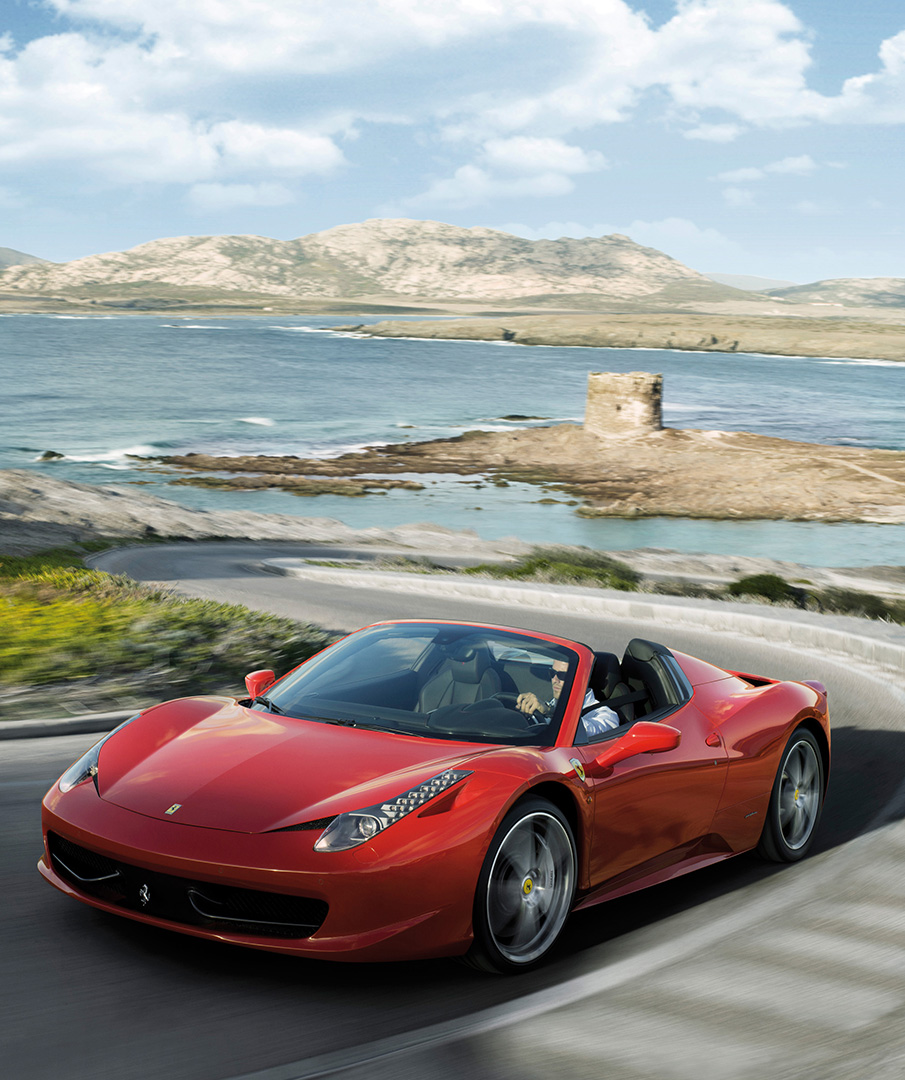
The E-DIFF3 is now even more seamlessly integrated with the F1-Trac and uses a series of its parameters (including grip estimation) both in positions in which F1- Trac is active (Sport – Race) and in which it is deactivated (CT-off and ESC-off).
This evolution means that torque distribution coming out of bends (Sport, Race, CT-off , ESC-off positions) is better than in previous models, resulting in improved traction, i.e. higher Longitudinal Acceleration values and better dynamic behaviour on the limit. This also means less steering wheel activity. The 458 Spider also delivers absolutely outstanding braking distances (100-0 km/h in 32.8 metres; 200-0 km/h in 128.5).
These superb figures come as a result of the development and optimisation of control logics and systems in collaboration with Bosch, the evolution of the Ferrari Pre-Fill logic to minimise response times, specific ABS calibration for medium-high grip situations, and the integration of E-DIFF3 and ABS control logics to guarantee both more precise vehicle speed estimation in braking under ABS, resulting in better control of braking torque, and greater stability. The 458 Spider’s tyres were also specially developed with a particular focus on grip to bring them in line its superb braking system.

SCM (Magnetorheological Suspension Control) suspension made its debut on the 599 GTB in 2006 and the 458 Spider is equipped with the evolved SCM2 version. It uses a viscous fluid which reacts instantaneously to an electronically controlled magnetic field generated inside the damper. The control software adjusts the intensity of the magnetic field every millisecond. The ECU (-50 percent input time) and the dampers themselves have both evolved since the previous generation.
TCarbon-ceramic material brakes have been fitted as standard with every Ferrari model since January 2008. Aside from guaranteeing benchmark braking, carbon-ceramic material discs require minimal maintenance.


STYLING AND AERODYNAMIC
The hard top’s movement and the way in which its two sections fold away into the compartment in front of the engine have resulted in a highly original division of the volumes. The constraints involved in a retractable folding hard top actually provided the inspiration for forms that neatly resolve the problems of its packaging, both from the point of view of the car’s layout and its aerodynamics. While the bonnet and the flanks didn’t require any modification at all, the rear had to be completely redesigned.

The hard top is made up of two sections that fold so as to take up very little space and without raising the line of the rear deck.The two panels rotate rearwards separately through 180 degrees, one on top of the other, thus reducing bulk to the minimum. This allowed the designers to create a storage area behind the two seats that is large enough to take a golf bag. The main aerodynamic problem in transforming the coupé into a spider involves the fact that there is no rear windscreen to direct and channel air flow towards the rear spoiler to create downforce.
Pininfarina focused on two central elements: the buttresses, a classic Maranello styling cue, and the engine cover. Their forms were redesigned to tackle the turbulence normally generated by spiders.The buttresses in particular were designed to integrate various Spider functionalities. They first and foremost act as roll-bars: unlike the 430, the passenger protection and reinforcement structures are actually now a part of the buttresses.
From an aerodynamic point of view, the tapering volumes of the buttresses, which flow onto the engine cover, actually channel airflow very efficiently towards the rear radiators.
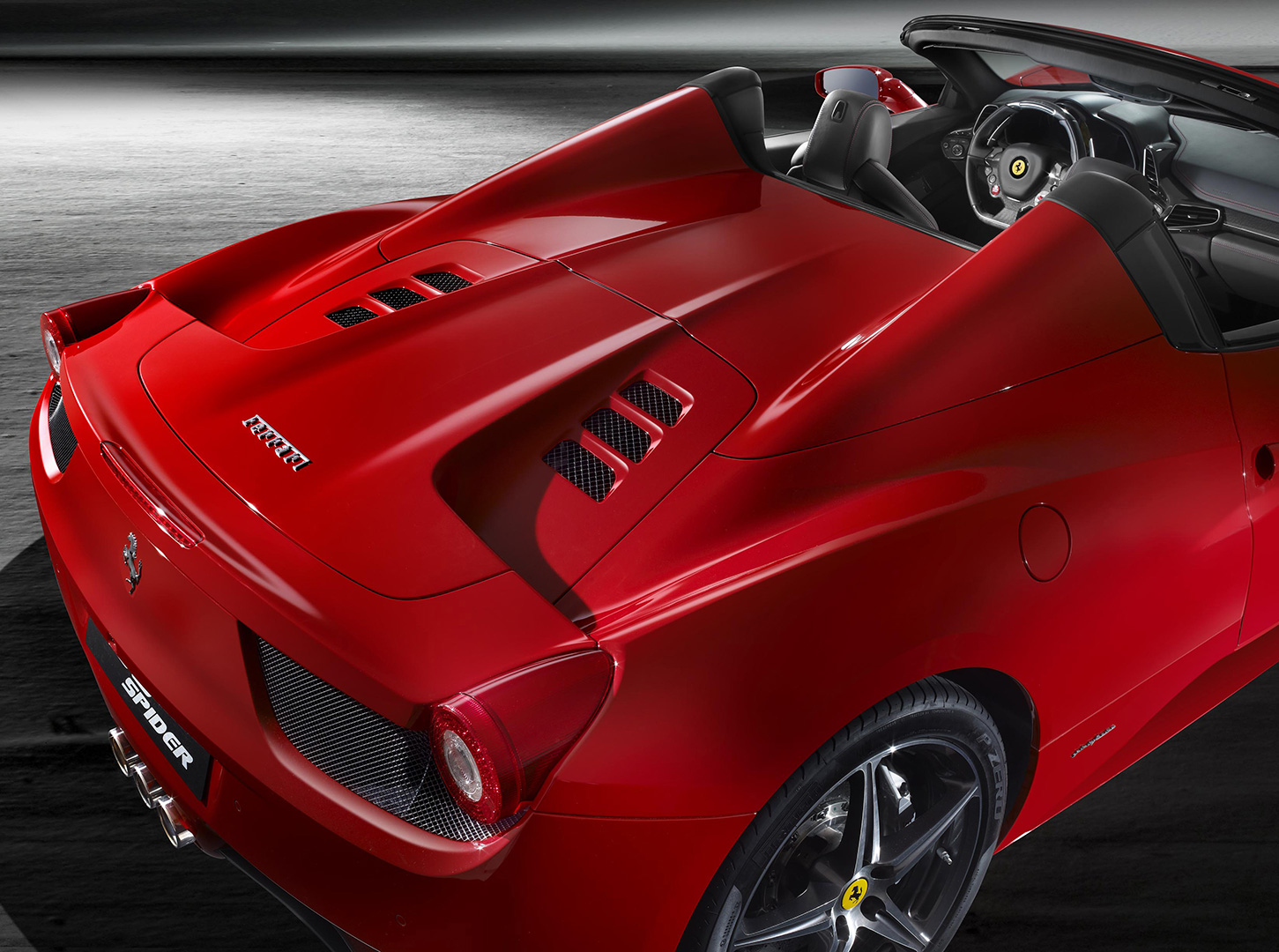
The rear scoops are larger than on the coupé and, apart from cooling the oil radiators, they also feed the engine air intakes. The more generous size of the intakes themselves increases the nolder effect thanks to the way the air flow speed slows on the way in and to the greater volume of air affected by that reduced speed.
The engine cover features six air vents, whose number and form are a modern twist on a traditional Ferrari styling cue. Between the two buttresses, there is an electric glass window which, as well as being something of a recognisable styling statement for mid-rear-engined Ferraris of the past, is also an effective wind-stop, as already described.
One major innovation from the F430 Spider is the fact that the engine is no longer on view. Function-driven design dictated a change was in order, with the focus on sculpting forms rather than ensuring engine visibility, which, in any case, would not have been complete. Furthermore, eliminating the glass was as much an advantage from a weight-saving perspective as the introduction of the retractable aluminium hard top.
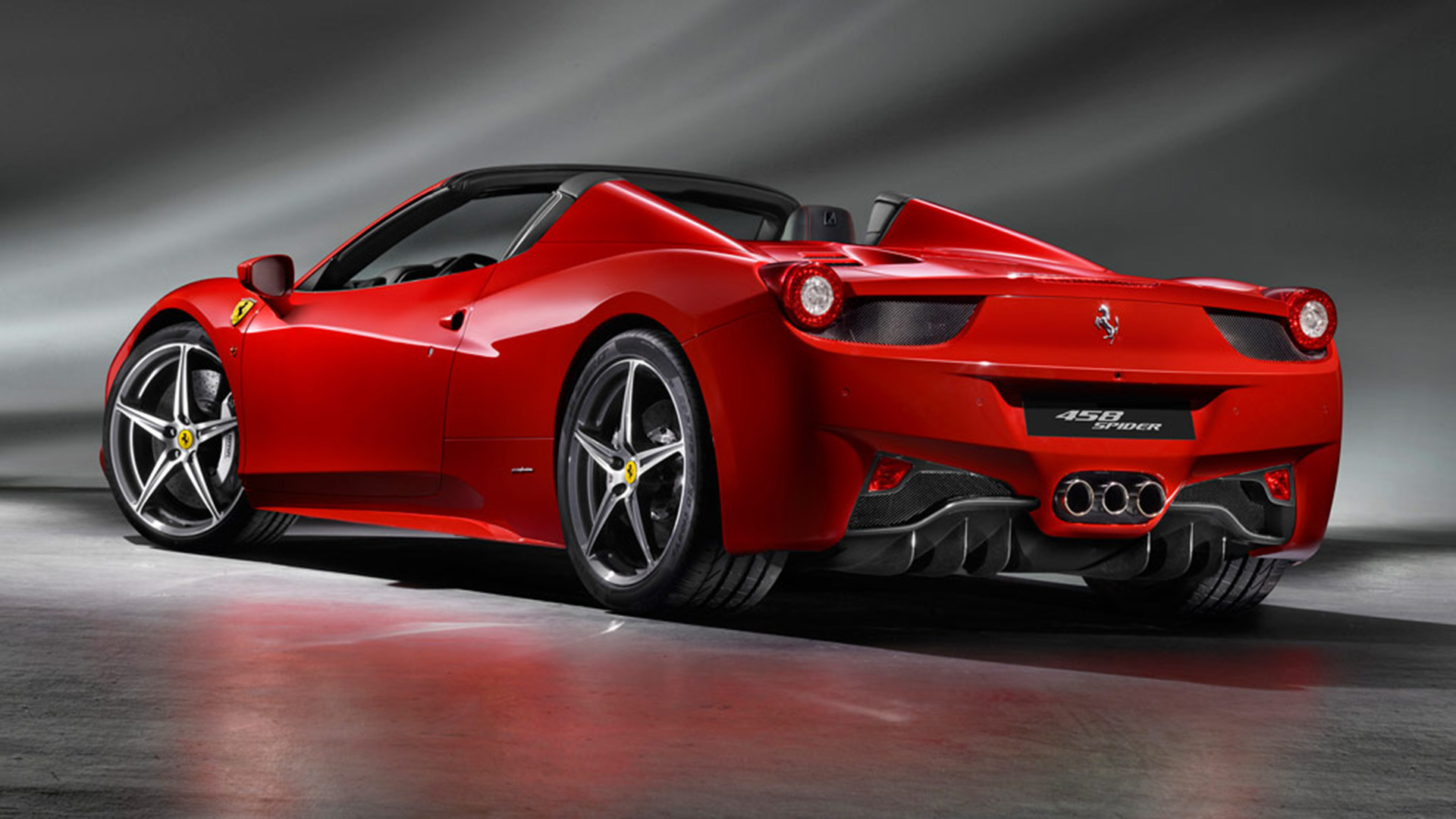

A SEAMLESS COMBINATION OF COMFORT AND ELEGANCE
The Ferrari Design has lavished meticulous attention on both space and ergonomics, as well as on finish and trim as befits the car's positioning within the range.
The 458 Spider retains the 458 Italia's focus on ensuring the driver feels at the very centre of the car with a Formula 1 cockpit-style driver layout which is designed specifically to minimise the driver's hand movements for complete concentration and focus on the road at all times.
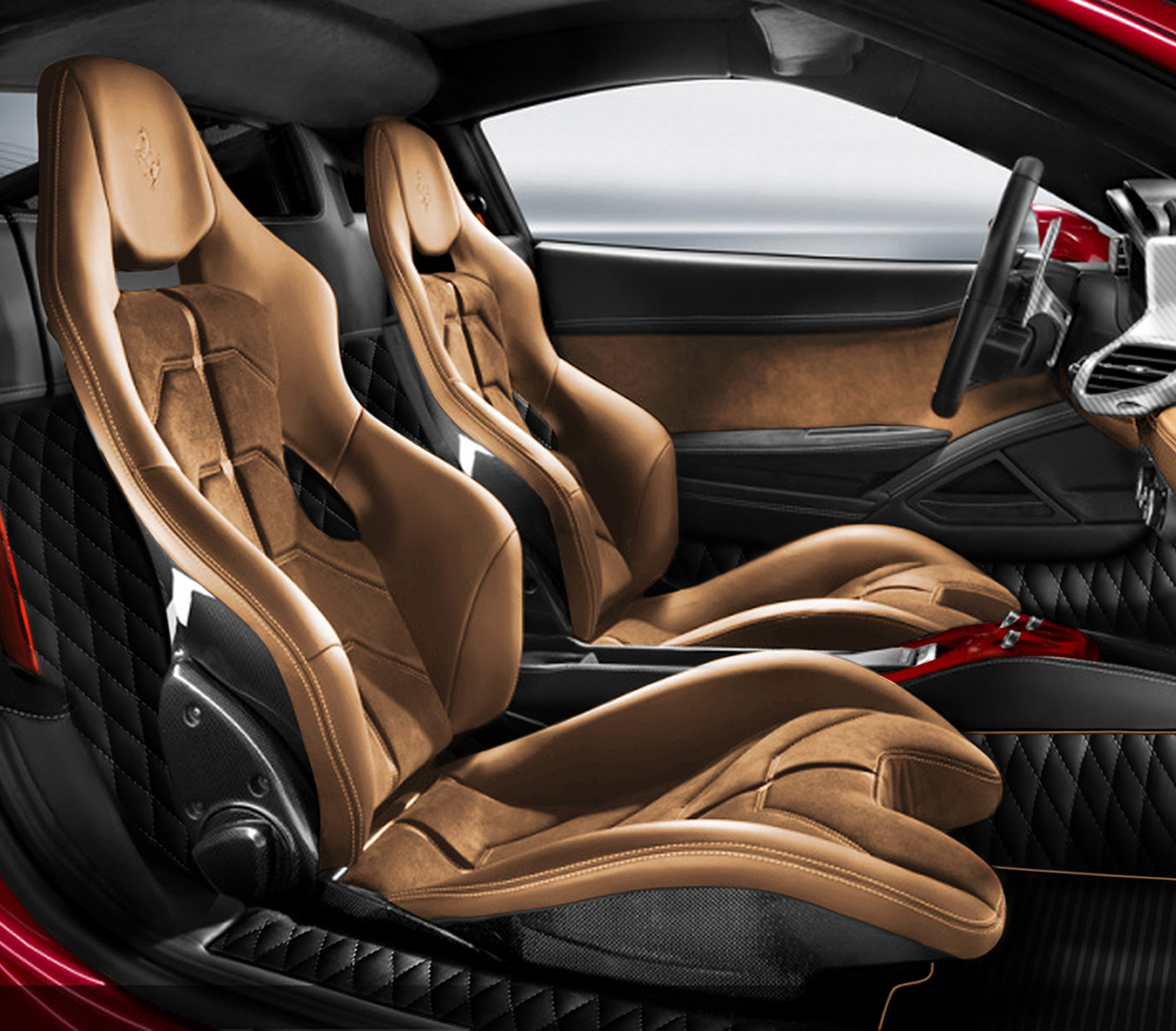
The double curvature roof and seating are also ergonomically designed so that even very tall occupants of over 6 ft 4 in. can be easily and comfortably accommodated. With respect to its coupé sibling, the 458 Spider, however, is a slightly less extreme car, more oriented towards regular weekday driving and for weekend trips with a friend/partner. The interior is simple and there is plenty of luggage stowage space in the front boot and on the rear bench. Bespoke luggage sets are available for each of these and feature a stylish motif inspired by the six air intakes of the engine cover. The front boot has a 58-litre capacity and a suit bag is available that can be put on top of the optional three fitted suitcases.
The rear bench can be used to stow a regular-sized golf bag - even one containing longer clubs. The space was created thanks to the redesign of the cross beam which guarantees the chassis' torsional rigidity and which supports the two structural reinforcements that act as roll-over protection for the cockpit. The structural protection has been cleverly incorporated into the 458 Spider's styling, thanks to the unique design of the B-pillar buttresses. Two of Ferrari's bespoke fitted suitcases fit perfectly into the space available behind the seats.

The elimination of the usual indicators stalks and the clustering of controls on the steering wheel further underscores the 458 Spider's innate connection to the racing world. The fact that the driver can easily reach all of the commands without even loosening his grip on the steering wheel ensures optimal performance in all kinds of driving conditions.
This is what Ferrari calls the Human Machine Interface and it really does put the driver in absolute control of his car.
To guarantee superbly sporty yet safe driving, the 458 Spider also comes equipped with VDA (Vehicle Dynamic Assistance) which gives the driver moment-to-moment evaluations of the vehicle status and the performance levels it is capable of achieving. Activated when the manettino is in its RACE, CT OFF and ESC OFF settings, VDA makes driving even more exhilarating and safe as it provides a clearer understanding of the conditions most suited to the car at any particular moment. An algorithm estimates the car's status (brake, engine and tyre temperature) on the basis of the dynamics of certain parameters (lateral and longitudinal acceleration, engine speed, vehicle speed...), indicating the most suitable conditions for the car to the driver.
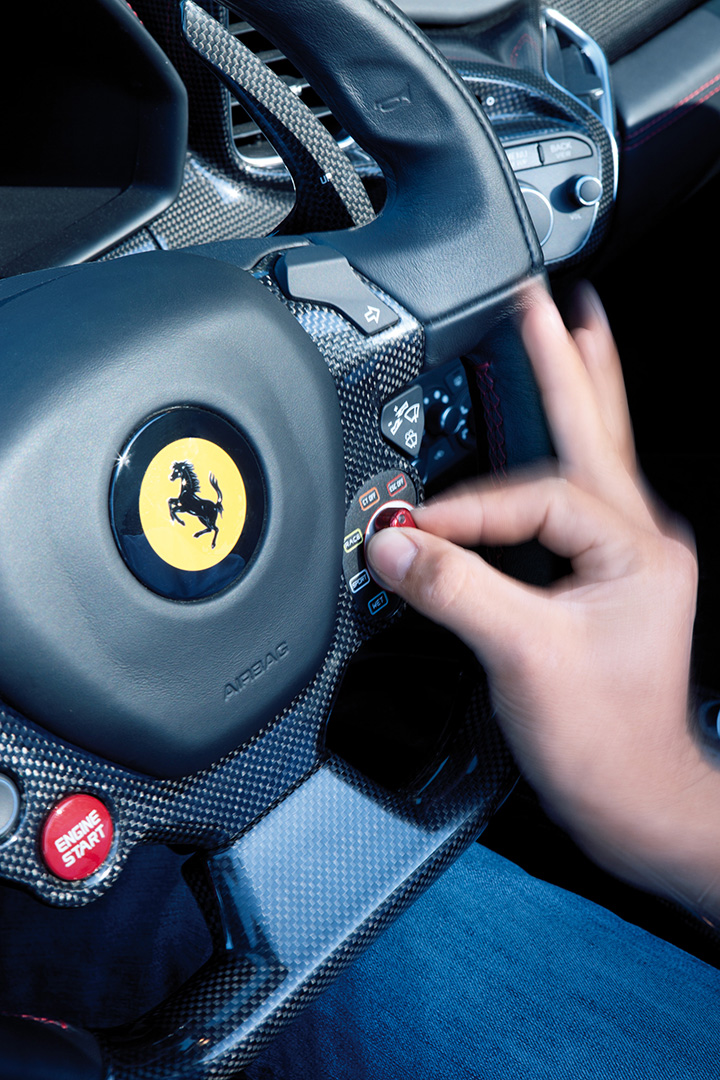
- V8ENGINE
- 4497 ccTOTAL DISPLACEMENT
- 570 CVMAXIMUM POWER @ 9000 RPM
- 320 km/hTOP SPEED
- Overall length178.2 in (4527 mm)
- Overall width76.3 in (1937 mm)
- Height47.7 in (1211 mm)
- Wheelbase104.3 in (2650 mm)
- Front track65.8 in (1672 mm)
- Rear track63.2 in (1606 mm)
- Kerb weight*3384 lbf (1535 kgf)
- Dry weight*3153 lbf (1430 kgf)
- Weight distribution42% front - 58% rear
- Boot capacity8.12 cu ft (230 l)
- Rear bench capacity2.05 cu ft (58 l)
- Fuel tank capacity22.7 US gallon - 4.2 US gallon reserve (86 l - 16 l riserve)
- Front235/35 20" x 8.5"
- Rear295/35 20" x 10.5"
- Front15.7 x 8.8 x 1.4 in - isoF142 (398 x 223 x 36 mm - isoF142)
- Rear14.2 x 9.2 x 1.3 in - isoF142 (360 x 233 x 32 mm - isoF142)
- TypeV8 - 90° - Direct Injection - Dry Sump
- Bore and Stroke3.7 x 3.2 in (94 x 81 mm)
- Total displacement274.4 cu in (4497 cm³)
- Compression ratio12.5:1
- Maximum Power419 kW (570 CV)** @ 9000 rpm
- Maximum Torque398 lbf ft (540Nm) @ 6000 rpm
- Specific Output1.53 kW/cu in (127 CV/l)
- Maximum revs per minute9000 rpm
- Maximum speed199 mph (320 km/h)
- 0-62 mph (0-100 km/h)< 3.4s
- 0-124 mph (0-200 km/h)< 10.8s
- 0-437 yd (0-400 m)11.4s
- 0-1093 yd (0-1000 m)20.5s
- 62-0 mph (100-0 km/h)107.6 ft (32.8 m)
- 124-0 mph (200-0 km/h)421.6 ft (128.5 m)
- Dry weight/power ratio7.53 lbf/kW (2.51 kgf/CV)
- Fiorano Lap Time85.5s
- Fuel consumption***19.9 mpg (11.8 l/100 km)
- CO2 Emissions ***0.442 kgCO2/mile (275 g CO2/km)
- 7 gears F1 dual clutch transmission-
- E-Diff3, F1-Trac, High Performance ABS with Ferrari Pre-Fill-
- *With Forged Rims and Racing Seat
- **Included 3.7 kW by dinamic over pressure
- ***Combined cycle with HELE system (ECE+EUDC)
- Hard top
- Engine
- Architecture
- aerodynamics
- dynamics
- design
- interior
- Technical Details
- Media gallery
